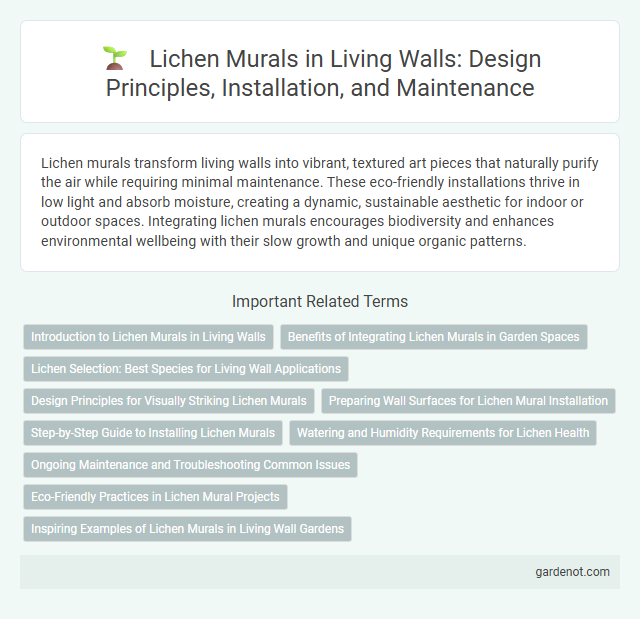Lichen murals transform living walls into vibrant, textured art pieces that naturally purify the air while requiring minimal maintenance. These eco-friendly installations thrive in low light and absorb moisture, creating a dynamic, sustainable aesthetic for indoor or outdoor spaces. Integrating lichen murals encourages biodiversity and enhances environmental wellbeing with their slow growth and unique organic patterns.
Introduction to Lichen Murals in Living Walls
Lichen murals in living walls provide a unique, low-maintenance option for adding natural texture and color to interior and exterior spaces. These murals use preserved lichen, which retains its softness and vibrant hues without needing sunlight or watering, making them ideal for environments with limited natural light. Incorporating lichen murals enhances indoor air quality and offers sound absorption benefits while creating visually striking, eco-friendly design elements.
Benefits of Integrating Lichen Murals in Garden Spaces
Lichen murals enhance garden spaces by improving air quality through natural pollutant absorption and providing a low-maintenance, sustainable green wall option. Their unique textures and natural colors create visually appealing, eco-friendly designs that support biodiversity by offering habitats for small insects. Incorporating lichen murals also aids in temperature regulation and noise reduction, contributing to a healthier and more serene outdoor environment.
Lichen Selection: Best Species for Living Wall Applications
Selecting the right lichen species for living wall applications is crucial to ensure durability, low maintenance, and aesthetic appeal. Commonly preferred species include Cladonia, Usnea, and Hypogymnia, known for their resilience to varying light and humidity conditions. These lichens thrive in vertical environments, offering natural insulation and air-purifying benefits while maintaining vibrant textures and colors over time.
Design Principles for Visually Striking Lichen Murals
Lichen murals leverage the natural texture and color variations of lichen to create visually striking living walls that emphasize organic patterns and contrast. Key design principles include balancing color palettes with diverse lichen species, incorporating asymmetry to mimic natural growth, and ensuring optimal light and humidity conditions for lichen health and longevity. Integrating natural shapes and layered depths enhances visual interest, making lichen murals dynamic focal points in interior or exterior spaces.
Preparing Wall Surfaces for Lichen Mural Installation
Properly preparing wall surfaces for lichen mural installation involves cleaning and ensuring the area is dry, smooth, and free of dust or debris to promote adhesion and longevity. Surfaces made of wood, concrete, or drywall often require priming with a suitable, non-toxic sealant to provide a stable base for the lichen panels. A well-prepared wall enhances the aesthetic appeal and durability of the living wall, supporting the natural growth and vibrant look of the lichen mural.
Step-by-Step Guide to Installing Lichen Murals
To install a lichen mural, begin by selecting a clean, sturdy surface such as drywall or wood and ensuring it is dry and free of dust. Apply a moisture-retentive base layer like moss adhesive or a specialized lichen glue to promote adherence and growth. Arrange the preserved lichen pieces on the base, pressing gently to secure them, then mist the mural lightly to maintain humidity and encourage longevity.
Watering and Humidity Requirements for Lichen Health
Lichen murals thrive in environments with consistent humidity levels between 50% and 70%, essential for preventing desiccation and promoting growth. Watering should be minimal and indirect, as lichens absorb moisture primarily from the air rather than soil, making misting or ambient humidity control preferable. Overwatering can lead to mold and decay, so maintaining balanced moisture without saturation ensures optimal lichen health and longevity.
Ongoing Maintenance and Troubleshooting Common Issues
Lichen murals require minimal ongoing maintenance, primarily involving periodic misting to maintain humidity and occasional dusting to ensure vibrancy. Common issues include discoloration and detachment, often caused by excessive sunlight or inadequate moisture levels, which can be remedied by adjusting environmental conditions. Routine inspection helps identify early signs of damage, enabling prompt troubleshooting and prolonging the mural's aesthetic appeal.
Eco-Friendly Practices in Lichen Mural Projects
Lichen murals utilize natural, sustainable materials that require minimal water and no pesticides, promoting eco-friendly practices in urban green art projects. These murals enhance air quality by absorbing pollutants and producing oxygen, contributing to healthier city environments. Integrating lichen into wall designs supports biodiversity by providing habitats for microfauna, making them a sustainable choice for green building initiatives.
Inspiring Examples of Lichen Murals in Living Wall Gardens
Lichen murals in living wall gardens showcase unique textures and natural palettes, enhancing urban green spaces with low-maintenance biodiversity. Examples like the Kew Gardens' lichen wall highlight ecological benefits, promoting air purification and habitat for microfauna. Integrations in biophilic design projects demonstrate how lichen art fosters sustainable aesthetics while supporting environmental health.
Lichen mural Infographic

 gardenot.com
gardenot.com